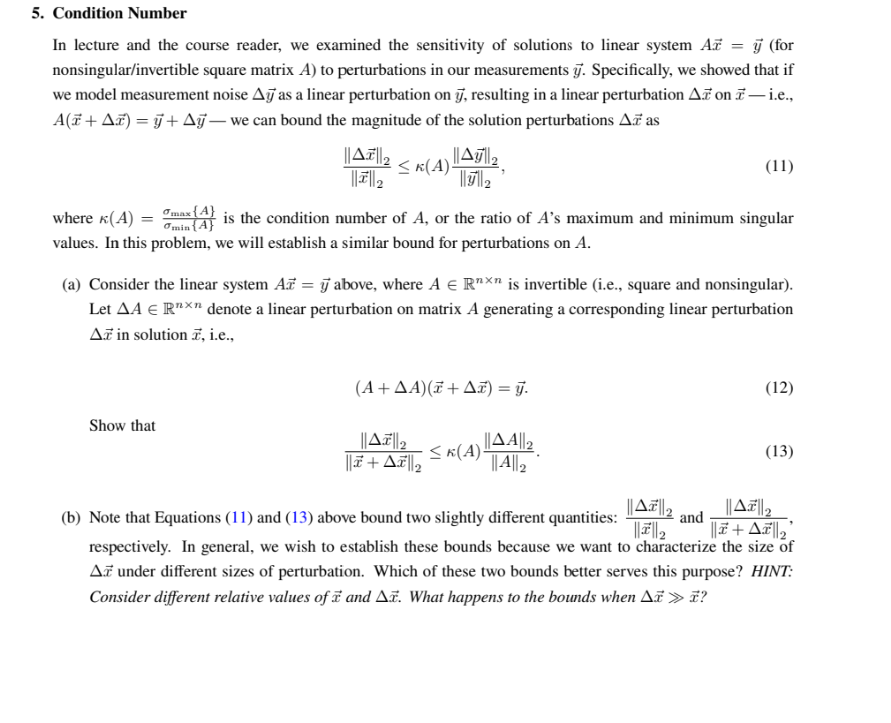In lecture and the course reader, we examined the sensitivity of solutions to linear system A y (for nonsingular/invertible square matrix A) to perturbations in our measurements 7. Specifically, we showed that if we model measurement noise Ay as a linear perturbation on y, resulting in a linear perturbation A on i.e., A(z+Ax) = ý + A- we can bound the magnitude of the solution perturbations Az as ≤K(A). max |||||2 ||||2 Show that where K(A) = is the condition number of A, or the ratio of A's maximum and minimum singular values. In this problem, we will establish a similar bound for perturbations on A. ||||2 . ||||2 (a) Consider the linear system A = above, where A E Rnxn is invertible (i.e., square and nonsingular). Let AA € Rnxn denote a linear perturbation on matrix A generating a corresponding linear perturbation Az in solution , i.e., (Α + ΔΑ)(* + Δ.π) = g. ||AT||2 || +AT||₂ (11) ||Δ.Α||2 ||A||2 ≤K(A). (12) (13) and (b) Note that Equations (11) and (13) above bound two slightly different quantities: ||A||2 ||Δ.||2 ||||₂ || +A||₂ respectively. In general, we wish to establish these bounds because we want to characterize the size of A under different sizes of perturbation. Which of these two bounds better serves this purpose? HINT: Consider different relative values of and A. What happens to the bounds when ▲x » ?
In lecture and the course reader, we examined the sensitivity of solutions to linear system A y (for nonsingular/invertible square matrix A) to perturbations in our measurements 7. Specifically, we showed that if we model measurement noise Ay as a linear perturbation on y, resulting in a linear perturbation A on i.e., A(z+Ax) = ý + A- we can bound the magnitude of the solution perturbations Az as ≤K(A). max |||||2 ||||2 Show that where K(A) = is the condition number of A, or the ratio of A's maximum and minimum singular values. In this problem, we will establish a similar bound for perturbations on A. ||||2 . ||||2 (a) Consider the linear system A = above, where A E Rnxn is invertible (i.e., square and nonsingular). Let AA € Rnxn denote a linear perturbation on matrix A generating a corresponding linear perturbation Az in solution , i.e., (Α + ΔΑ)(* + Δ.π) = g. ||AT||2 || +AT||₂ (11) ||Δ.Α||2 ||A||2 ≤K(A). (12) (13) and (b) Note that Equations (11) and (13) above bound two slightly different quantities: ||A||2 ||Δ.||2 ||||₂ || +A||₂ respectively. In general, we wish to establish these bounds because we want to characterize the size of A under different sizes of perturbation. Which of these two bounds better serves this purpose? HINT: Consider different relative values of and A. What happens to the bounds when ▲x » ?
Linear Algebra: A Modern Introduction
4th Edition
ISBN:9781285463247
Author:David Poole
Publisher:David Poole
Chapter4: Eigenvalues And Eigenvectors
Section4.6: Applications And The Perron-frobenius Theorem
Problem 70EQ
Related questions
Question
100%

Transcribed Image Text:5. Condition Number
In lecture and the course reader, we examined the sensitivity of solutions to linear system Az = y (for
nonsingular/invertible square matrix A) to perturbations in our measurements y. Specifically, we showed that if
we model measurement noise Ay as a linear perturbation on y, resulting in a linear perturbation A on 7-i.e.,
A(z+Ax) =ý + Ay- we can bound the magnitude of the solution perturbations Az as
||AT||2
||||₂
max
Show that
||||| 2
||||₂
≤K(A)!
where K(A) =
is the condition number of A, or the ratio of A's maximum and minimum singular
values. In this problem, we will establish a similar bound for perturbations on A.
(a) Consider the linear system A = y above, where A = R¹x is invertible (i.e., square and nonsingular).
Let AA € Rnxn denote a linear perturbation on matrix A generating a corresponding linear perturbation
Az in solution 7, i.e.,
(Α + ΔΑ)(x + Δt) = y.
||AT||2
|| +AT||₂
(11)
||ΔΑ||2|
||A||2
≤K(A).
(12)
(13)
||Δ.||2
||Δ.7|2
||||₂ || +A||₂
(b) Note that Equations (11) and (13) above bound two slightly different quantities:
and
respectively. In general, we wish to establish these bounds because we want to characterize the size of
A under different sizes of perturbation. Which of these two bounds better serves this purpose? HINT:
Consider different relative values of and A. What happens to the bounds when Ax» ?
Expert Solution
This question has been solved!
Explore an expertly crafted, step-by-step solution for a thorough understanding of key concepts.
This is a popular solution!
Trending now
This is a popular solution!
Step by step
Solved in 4 steps with 29 images

Recommended textbooks for you

Linear Algebra: A Modern Introduction
Algebra
ISBN:
9781285463247
Author:
David Poole
Publisher:
Cengage Learning

Algebra & Trigonometry with Analytic Geometry
Algebra
ISBN:
9781133382119
Author:
Swokowski
Publisher:
Cengage

Linear Algebra: A Modern Introduction
Algebra
ISBN:
9781285463247
Author:
David Poole
Publisher:
Cengage Learning

Algebra & Trigonometry with Analytic Geometry
Algebra
ISBN:
9781133382119
Author:
Swokowski
Publisher:
Cengage